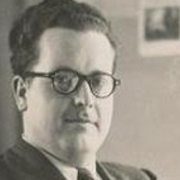
Peter Read
Peter Read, the man whose television programmes inspired a generation of New Zealanders to take an interest in the sky above them, was a self taught astronomer.
Born in Wellington in 1923, he became interested in the stars as a teenager and started an astronomy club as a third former at Rongotai College. His strongest subject was drawing and in 1939 he left school to join the National Publicity Studios where he created posters, displays and murals.
Read saw service during World War II as an Air Force flight mechanic in the North Solomons. His wartime experiences would have a long-lasting effect on his life. He developed an interest in militaria which he began to actively collect; but, more importantly, a stint with a concert party awakened the performer within him. In 1949 he started acting in NZBC radio dramas, and he later released two comedy albums.
He also took up painting and his works were hung by the New Zealand Academy of Fine Arts over the next decade. His early interest was in landscapes, but increasingly surrealism took over — and these paintings were influenced by his continuing interest in astronomy.
From 1947, Read lectured at the Carter Observatory in Wellington – going on to become Vice President then President of the Royal New Zealand Astronomical Society, President of the Wellington Planetarium Society and a Fellow of the Royal Astronomical Society. He also built his own observatory in the backyard of his Miramar home.
Television hit Wellington in 1961 — the same year Russian cosmonaut Yuri Gargarin made the first manned spaceflight. With growing public interest in space, producer Roy Melford decided that Read, with his acting ability and interest in the stars, would be an ideal person to front an astronomy show. A Closer Look at the Moon — a 20 minute special — screened in October 1961; and it was followed by 10-part series The Infinite Sky. Night Sky ran on a monthly basis from 1963 and remained on Kiwi screens until 1974 (regularly featuring backdrops painted by Read himself).
In 1966 Read also began presenting Horizon: an additional series about space and the stars, but with more of a general science bent. By now he was also the presenter of Town and Around, Wellington’s nightly regional news show — a role he would fill for five years, including on this end of year special.
With his horn-rimmed spectacles and avuncular manner, Peter Read became one of the most familiar local faces on television in the 60s. As the space race accelerated, he was there on Night Sky to explain each new development (as well as highlighting the month to month changes in the heavens).
In 1969, while New Zealand waited for footage to arrive of Neil Armstrong setting foot on the moon, Peter Read was in the studio adlibbing a half hour show and demonstrating the manoeuvres of the moon landing module (although it was later discovered that the model he used wasn’t quite the correct one).
In 1971 he received an International Visitor grant from the US Department of State to visit Cape Canaveral and witness an Apollo launch; and, in 1972, he was featured alongside veteran sports journalist TP MacLean and conductor Maxwell Fernie in Take Three Passions — a Tony Williams film featuring eminent people talking about their fields of expertise.
Night Sky celebrated its 10th anniversary in 1973; but it was cancelled by the NZBC at the end of the following year. At that point it was New Zealand’s longest running TV show, and Read the country’s longest serving presenter.
Read was shocked by the decision, and further disappointment followed when he was passed over for the position of director of the new Wellington Planetarium (for which he had done considerable fundraising). His last appearance on television was also disheartening as he passed on most of the questions that Peter Sinclair asked him, as a contestant on Mastermind.
Peter Read — the people’s astronomer who was in his element as a populariser, rather than a pioneer — died in 1981.
Profile written by Michael Higgins
Sources include
Carter Observatory, Wellington ‘Man on the Moon’ – The Listener, 20 October 1961, page 6
Rob Keyzer, ‘A Decade of Looking into Space’ – The Listener, 15 October 1973, page 23
Unknown writer, ‘TV Pioneer Dies at 58’ – The NZ Herald, 13 August 1981, page 17